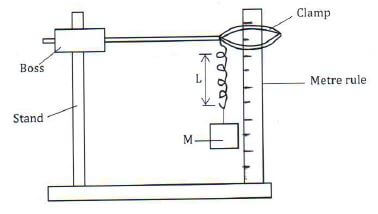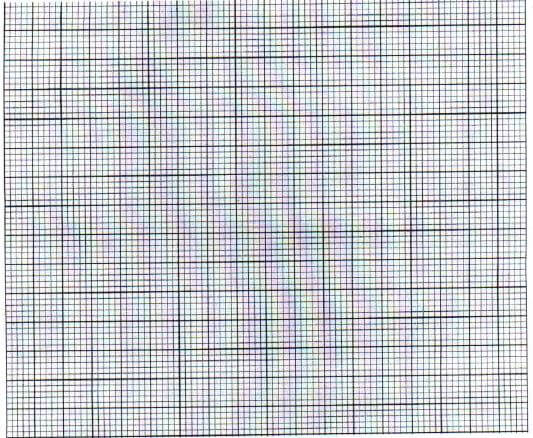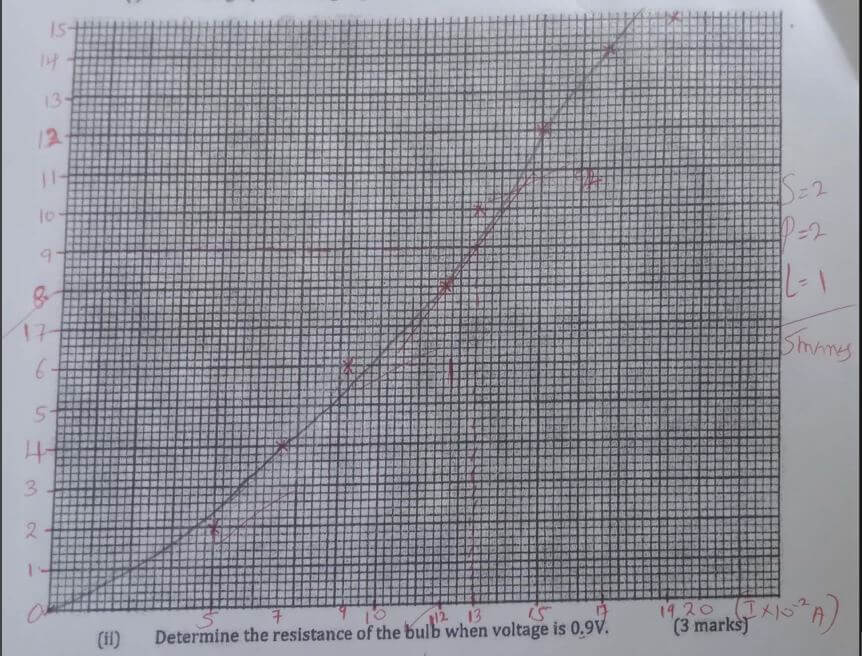QUESTIONS
QUESTION 1
PART A1
- You are provided with the following apparatus.
- Helical spring with pointer
- One clamp, one stand and one boss
- A stop watch
- One 50g mass
- Two 100g masses
Proceed as follows:
- Suspend the spring vertically alongside a clamped metre rule as shown in the diagram so that the pointer slide along the millimeter scale of the metre rule as shown in the figure below.

- Measure the length Lo of the unloaded spring. (1/2 mark)
Lo = ................... - Attach a mass of 100g on the spring and measure the new length L of the spring. Record this in the table. (5 marks)
Table
- Calculate the change in length e = (L-Lo)m due to the mass of 100g and record in the table.
- Repeat the procedure in (i) - (iv) for mass of 150g and 200g.
- Calculate the value of K given:
K = w(N) and find the average value of K. (1/2 mark)
e(M)
K Average =
PART A2
-
- Using the same set up as in Part A above, attach the 100g on the spring and support it to stop oscillating
- Pull the mass through a small distance vertically downwards and release it to make vertical oscillations and record the time for 10 oscillations and determine the periodic time (s)
- Hence complete the table to get T2(s2) and the value of K = 39.49 x M(Kg)
T2(S2)
where M = mass used and T2(S2) is its periodic time T squared. - Table (31/2 marks)

- (1/2 mark)
PART B
(b)
You are provided with the following:
- A meter rule
- Complete stand
- One 50g mass and a 100g mass
- Three Pieces of thread 30cm each
- Some water in a beaker
- Liquid L in a beaker
- Tissue paper.
Proceed with the experiment as follows:
- Balance the meter rule on the stand and record the reading at this point.
Balance point = ......................... (1 mark)
(For the rest of the experiment, the balancing thread must be placed at this position) - Set up the apparatus as shown in the figure 4 below;
Use the thread provided to hang the masses such that the positions of the support can be adjusted.
The balance point is attained by adjusting the position of the 100g mass. Note that the distance X and D are measured from the supporting string and the 50g mass is fully submerged in water.
Record the values of X and D.
X = ............................(1 mark)
D = ...........................(1 mark)
Apply the principle of moments to determine the weight W of the 50g mass in water and hence determine the upthrust Uw in water. (2 marks)
W1 =
Uw =
Remove the 50g mass from the water and dry it using the tissue paper - Now balance the metre rule when the 50g mass is fully immersed in the liquid L.
Record the value of the distance X.
x = ...........................................(1 mark)
Apply the principle of moments to determine W2 of the 50g mass in the liquid L and hence determine the upthrust Ul in the liquid. (2 marks)
W2 =.......................................
UL = ..................................... - Determine the relative density R.D of the liquid L given that: (1 mark)
R.D = UL
UW - Find the density of liquid Lin kg/m3 (1 mark)
QUESTION 2
You are provided with the following apparatus
- Two dry cells and a cell holder
- A voltmeter
- An ammeter (0 - 1A)
- Potentiometer P
- A bulb and bulb holder
- 7connecting wires
- 4 crocodile clips
- A switch S
PART A
Set up the circuit as shown below.
Ensure the switch is off.
- Record the reading of the voltmeter when the switch is open
V1.....................................(1 mark) - Close the switch and record the voltmeter reading.
V2 .....................................(1 mark) - Explain the differences in the value of V2 and V1 (1 mark)
PARTB
- Set up the circuit as shown below.

Close the switch S and adjust the potentiometer P till the bulb lights brightest. Record the ammeter and voltmeter reading.
I...........................................(1 mark)
V.........................................(1 mark) - By adjusting the potentiometer P obtain the corresponding readings of the values of voltmeter readings given in the table. (6 marks)

- Plot a graph of voltage against current. (5 marks)

- Determine the resistance of the bulb when voltage is 0.9V. (3 marks)
- Explain the nature of the curve in the graph.(1 mark)
- Plot a graph of voltage against current. (5 marks)
MARKING SCHEME
QUESTION 1
PART A1
- You are provided with the following apparatus.
- Helical spring with pointer
- One clamp, one stand and one boss
- A stop watch
- One 50g mass
- Two 100g masses
Proceed as follows:
- Suspend the spring vertically alongside a clamped metre rule as shown in the diagram so that the pointer slide along the millimeter scale of the metre rule as shown in the figure below.

- Measure the length Lo of the unloaded spring. (1/2 mark)
Lo = 52.5 cm 1 dp own value. - Attach a mass of 100g on the spring and measure the new length L of the spring. Record this in the table. (5 marks)
Table
Mass(Kg) Weight ... (N) L(M) ± 0.01 é = (L - L0)(M) K = W (N)
é (M)0.10 1.0 0.55 0.15 - 0.035 28.57 - 66.67 0.15 1.5 0.57 0.35 - 0.055 21.83 - 34.29 0.20 2.0 0.59 0.055 - 0.075 26.67 - 36.36 - Calculate the change in length e = (L-Lo)m due to the mass of 100g and record in the table.
- Repeat the procedure in (i) - (iv) for mass of 150g and 200g.
- Calculate the value of K given:
K = w(N) and find the average value of K. (1/2 mark)
e(M)
K Average = 32.476 N/m ± 4
PART A2
-
- Using the same set up as in Part A above, attach the 100g on the spring and support it to stop oscillating
- Pull the mass through a small distance vertically downwards and release it to make vertical oscillations and record the time for 10 oscillations and determine the periodic time (s)
- Hence complete the table to get T2(s2) and the value of K = 39.49 x M(Kg)
T2(S2)
where M = mass used and T2(S2) is its periodic time T squared.Mass m (kg) Time for 10 oscillations t(s) T(S)
T = (t) ± 0.2
(10)T2(S)2 39.49 x M(Kg)
T2(S)20.10 4.00 - 8.00 0.600 0.16 - 0.64 10.97 0.15 7.00 - 11.00 0.910 0.504 - 1.210 7.154 0.20 9.00 - 13.00 1.140 0.81 - 1.69 6.077
Table (31/2 marks) - find the average value of K (1/2 mark)
K = 10.97 + 7.154 + 6.077
3
= 7.067 kg/s2 ± 0.4
PART B
(b)
You are provided with the following:
- A meter rule
- Complete stand
- One 50g mass and a 100g mass
- Three Pieces of thread 30cm each
- Some water in a beaker
- Liquid L in a beaker
- Tissue paper.
Proceed with the experiment as follows:
- Balance the meter rule on the stand and record the reading at this point.
Balance point = ...........5.0 cm ± 1.............. (1 mark)
(For the rest of the experiment, the balancing thread must be placed at this position) - Set up the apparatus as shown in the figure 4 below;
Use the thread provided to hang the masses such that the positions of the support can be adjusted.
The balance point is attained by adjusting the position of the 100g mass. Note that the distance X and D are measured from the supporting string and the 50g mass is fully submerged in water.
Record the values of X and D.
X = ..16.5 - 18.5 cm...(1 mark)
D = .39.2 - 41.2 cm..(1 mark)
Apply the principle of moments to determine the weight W of the 50g mass in water and hence determine the upthrust Uw in water. (2 marks)
F1D1 = F2D2
1 x 17.5 = 40 x W1 = 0.4375 N
W1 = 0.4375 N ± 0.01
Uw = 0.5 - 0.4375 = 0.0625 N ± 0.01
Remove the 50g mass from the water and dry it using the tissue paper - Now balance the metre rule when the 50g mass is fully immersed in the liquid L.
Record the value of the distance X.
x = ..17.2 - 19.2 cm...(1 mark)
Apply the principle of moments to determine W2 of the 50g mass in the liquid L and hence determine the upthrust Ul in the liquid. (2 marks)
F1D1 = F2D2
1 x 18.2 = HoW2
W2 = 0.455
W2 =..0.455 N ± 0.01
UL = ..0.5 - 0.455 = 0.045N ± 0.01... - Determine the relative density R.D of the liquid L given that: (1 mark)
R.D = UL
UW
0.045 = 0.72 ± 0.2
0.0625 - Find the density of liquid Lin kg/m3 (1 mark)
FL = R.O x PW
= 0.72 x 1.9/cm3
= 0.72 g/cm2 or 720 kg/m3
(700 - 740) kg/m3
QUESTION 2
You are provided with the following apparatus
- Two dry cells and a cell holder
- A voltmeter
- An ammeter (0 - 1A)
- Potentiometer P
- A bulb and bulb holder
- 7connecting wires
- 4 crocodile clips
- A switch S
PART A
Set up the circuit as shown below.
Ensure the switch is off.
- Record the reading of the voltmeter when the switch is open
V1..3.0 V ± 0.2....(1 mark) - Close the switch and record the voltmeter reading.
V2 ....2.7v ± 0.2......(1 mark) - Explain the differences in the value of V2 and V1 (1 mark)
some voltage is lost / dropped due to internal resistance (r) of the cells
PARTB
- Set up the circuit as shown below.

Close the switch S and adjust the potentiometer P till the bulb lights brightest. Record the ammeter and voltmeter reading.
I..0.23A ± 0.02...(1 mark)
V..2.1V ± 0.2 .(1 mark) - By adjusting the potentiometer P obtain the corresponding readings of the values of voltmeter readings given in the table. (6 marks)
Volts(V) 1.5 1.4 1.2 1.0 0.8 0.6 0.4 0.2 Current I(A) 0.19 0.17 0.15 0.13 0.12 0.09 0.07 0.05 - Plot a graph of voltage against current. (5 marks)

- Determine the resistance of the bulb when voltage is 0.9V. (3 marks)

- Explain the nature of the curve in the graph.(1 mark)
the resistance of the fillament bulb intensifies variably/ non-linearity
- Plot a graph of voltage against current. (5 marks)
Download Physics Paper 3 Questions and Answers - Kassu Jet Pre Mocks 2022.
Tap Here to Download for 50/-
Get on WhatsApp for 50/-
Why download?
- ✔ To read offline at any time.
- ✔ To Print at your convenience
- ✔ Share Easily with Friends / Students

